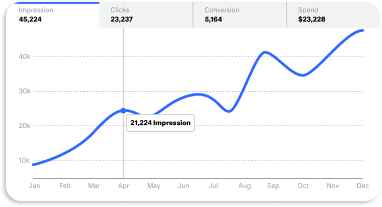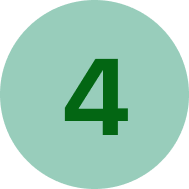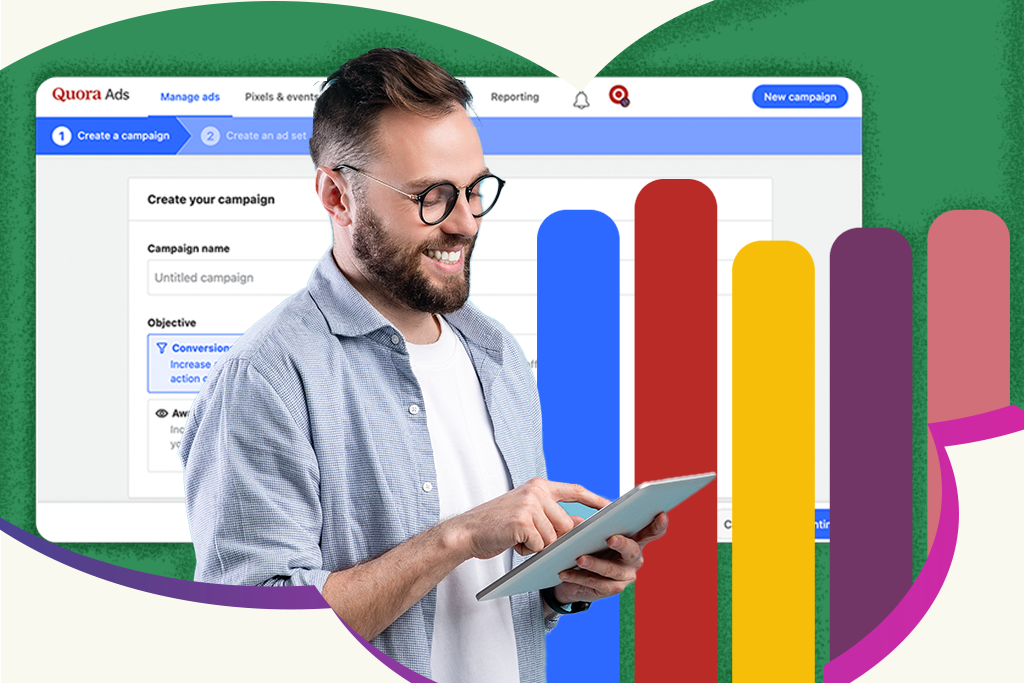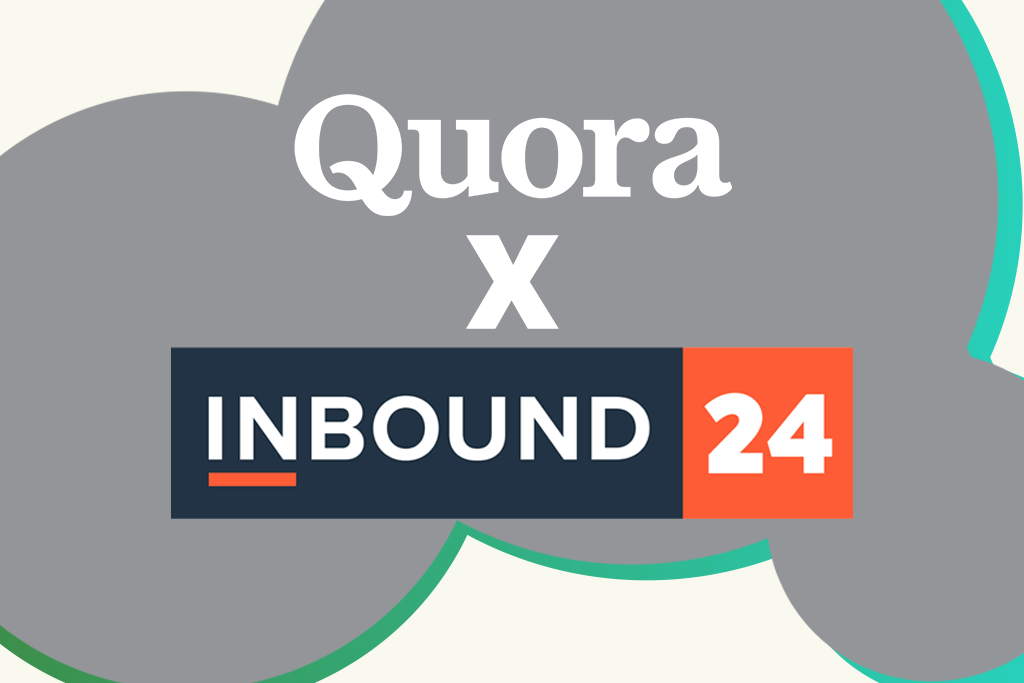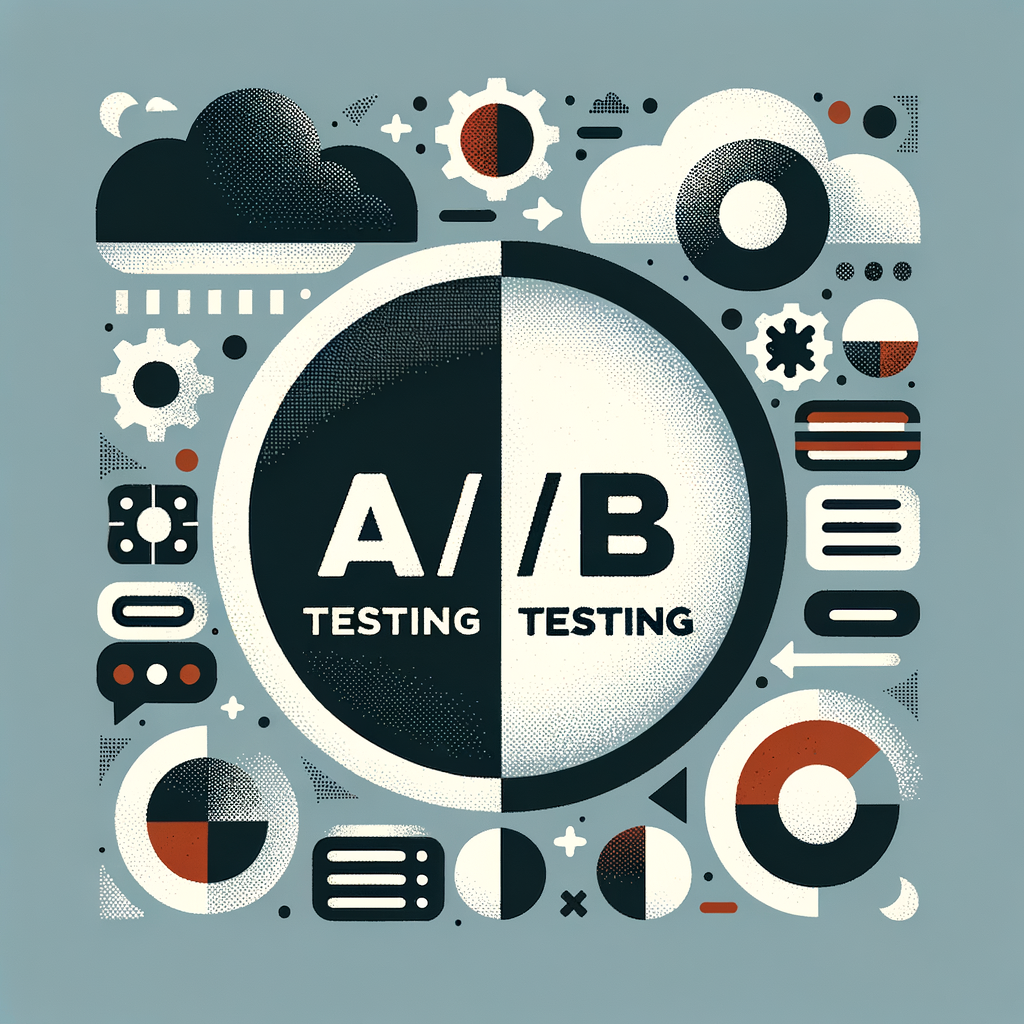Strategy for Traffic Campaigns on Quora
What does a successful traffic campaign look like on Quora? There are many strategies you can adopt to generate site traffic. The following recommendations are based on Quora’s best practices, so they can be adjusted to your business accordingly.
Traffic Campaign Structure
Your campaign’s structure is key to optimizing in the future. If you want targeting-specific reporting, separate your ad sets by primary targeting, geographic region, etc.

The following example is optimized to drive traffic to the fictional eCommerce brand, QSmart Travel.
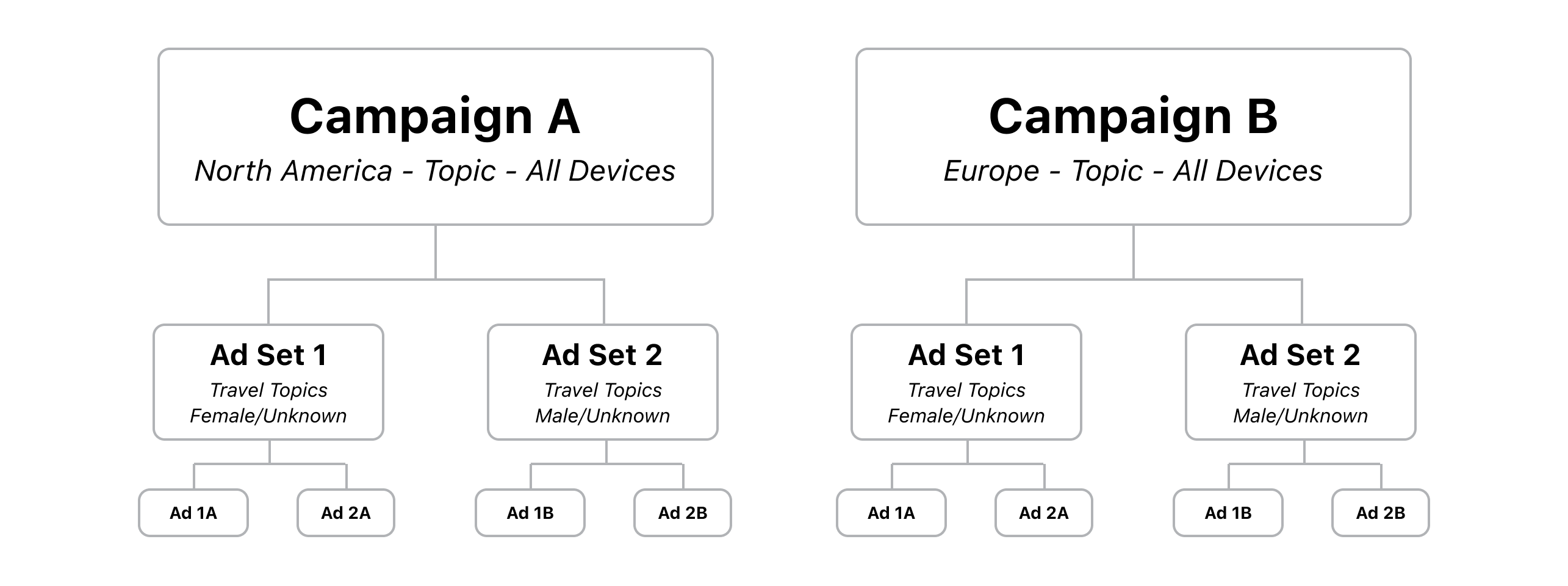
How does this structure help drive traffic?
- QSmart Travel can directly compare traffic from North American and European countries. This will help them control each geography’s budget.
- Since ad sets are separated by gender, QSmart can deliver custom ads to each user group, compare their performance, and optimize towards the best performing group (ex. increasing bids or updating ads).
- Per Quora’s best practices, the “Unknown” demographic group is included with each gender-split ad set. This optimizes traffic by letting QSmart Travel target users Quora could not identify as “Male” or “Female.”
- QSmart Travel can test additional sub-groups of topics (ex. hotels, airlines, etc.) within each campaign.
- This structure can easily be replicated for Interest, Audience, and Broad Targeting
Ad Creative
Image and Video Ads stand out among Quora’s predominantly text-based content. Take the following best practices into consideration when creating your ads.
- Test statement and question headlines: Questions are native to Quora and tend to drive higher CTRs.
- Capitalize on your audience’s pain points when you tailor the message: Test different CTAs (calls to action), but make it clear what users can expect when they visit your website.
- Incorporate branding: Consistent brand colors, logos, product shots, and key messaging are more memorable for users.
- Test different images with the same headlines, then test the winning image with a new headline: This will help you learn which ad elements drive the highest CTR.

Optimizing for Traffic
It is important to let ads run for one month before pausing or editing them. Optimizing your campaign pre-maturely can impact the volume and quality of traffic coming to your website.
- Pause underperforming ads: If one of your ads has a lower CTR than the others, pause it and replace it with a new creative. You can make minor adjustments to your headline, body text, image, or CTA to test.
- Pause underperforming ad sets: If an ad set is not driving traffic to your website, pause it. This will reallocate your budget to the remaining, successful ad sets.
- Expand your targeting: Test topics and interests based on your audience’s persona. Alternatively, you can build Lookalikes from a past audience list. For maximum scale, utilize Broad Targeting.
- Exclude older traffic: If your goal is net-new traffic, create a Website Traffic Audience and exclude it in your ad sets. Scale may be reduced, however ads will deliver to users who haven’t visited your website for up to 180 days.
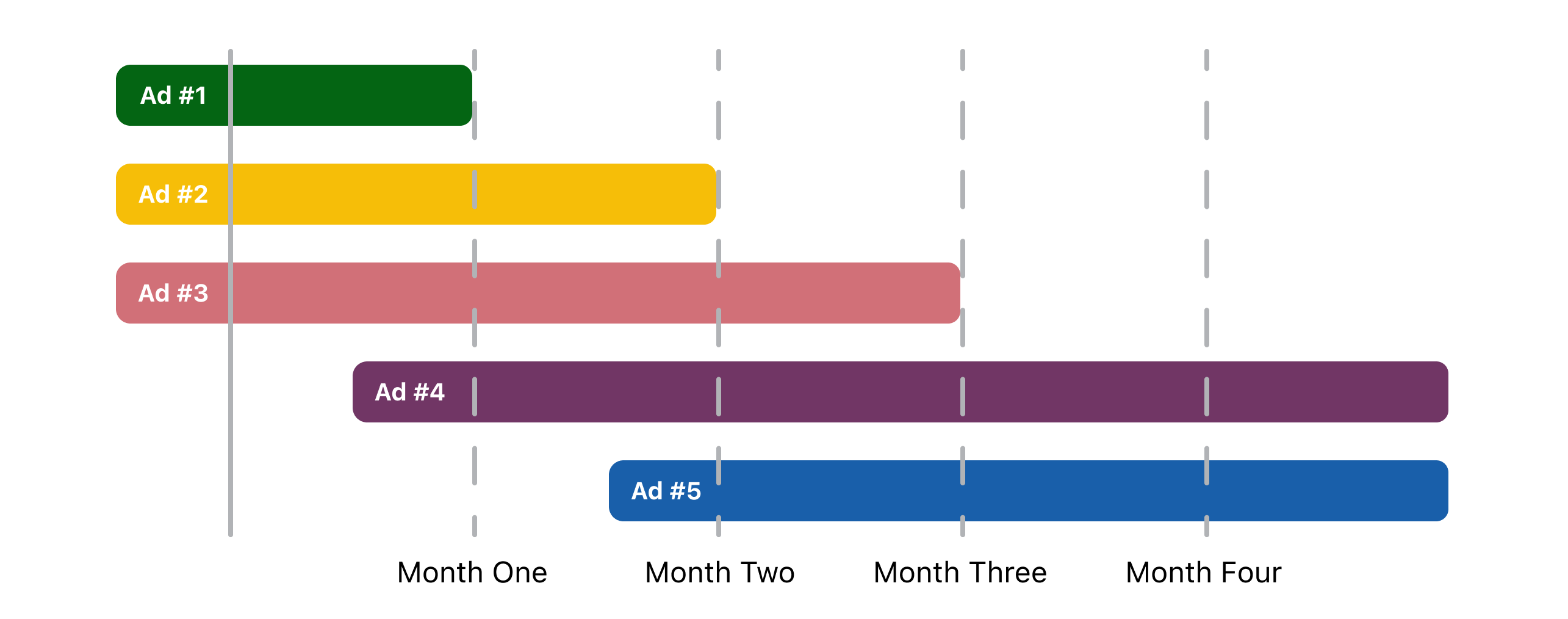
This campaign starts with three ads simultaneously. After one month, we see Ad #1 has a weak CTR. Ad #1 is deprecated and replaced with a new ad, Ad #4. After another month, underperforming ad #2 is replaced by a new Ad #5, and so on.
Key Takeaways for Traffic Campaigns
Do:
- Target multiple locations strategically: Global targeting tends to underbid for high traffic countries. To avoid losing auctions and impressions, group locations in a similar geography in one ad set. For example, an ad set targeting North America would include Canada and the United States.
- Organize ad sets based on what’s important to you: If you value device reporting, have separate mobile and desktop ad sets. This also applies to location, gender, and targeting reporting.
- Test and reiterate: Learning where your audience is on Quora can take time: Once your campaign runs for a month, pause underperforming ads and create new tests based on what was successful. There is always something new to test when it comes to targeting on Quora.
Don’t:
- Start with granular targeting: Question and Keyword Targeting can be harder to scale since they rely on page traffic and Quora’s inventory of questions, respectively.
- Test one ad per ad set: High CTRs are important to winning auctions on Quora. Have at least two ads running simultaneously so you can learn which elements of your ads generate the highest CTR.
- Underbid: Bid at the suggested level or higher. Increasing a bid from $1 to $3 will not result in $3 CPCs, for example. Instead, a $3 bid will make your ads eligible for more auctions compared to when your bid was $1.
Strategy for Awareness Campaigns on Quora
What does a successful awareness campaign look like on Quora? The following recommendations are based on Quora’s best practices, so they can be adjusted to your business accordingly.
Awareness Campaign Structure
To drive awareness about your brand, it is important to understand where your audience is on Quora. This can influence the way you structure your campaigns. If you want targeting-specific reporting, separate your ad sets by primary targeting, geographic region, etc.

The following example is optimized to drive awareness of the fictional eCommerce brand, QSmart Travel.

How does this structure help drive awareness?
- Topic and Question Targeting delivers ads to content relevant to QSmart Travel. Question History Targeting retargets users who previously read their targeted questions, and the questions answered by their Promoted Answers.
- Quora optimizes delivery to the best performing ads. Since Promoted Answers have higher average CTRs than image and text ads, they should have a separate campaign and budget to avoid disproportionate ad delivery.
- QSmart Travel can use this structure to compare each targeting type’s performance and allocate budget accordingly.
- Topic Targeting can have different costs on desktop and mobile. Separating ad sets by device allows QSmart Travel to bid competitively. QSmart Travel can test additional sub-groups of topics (ex. hotels, airlines, etc.) within their Topic campaign. This structure can also be replicated for Interest targeting.
- If Topic, Question, and Question History Targeting ad sets are in the same campaign, Topic Targeting will consume most of the budget since it has more volume. Keeping Question and Question History Targeting in a separate campaign allows them to run more efficiently.
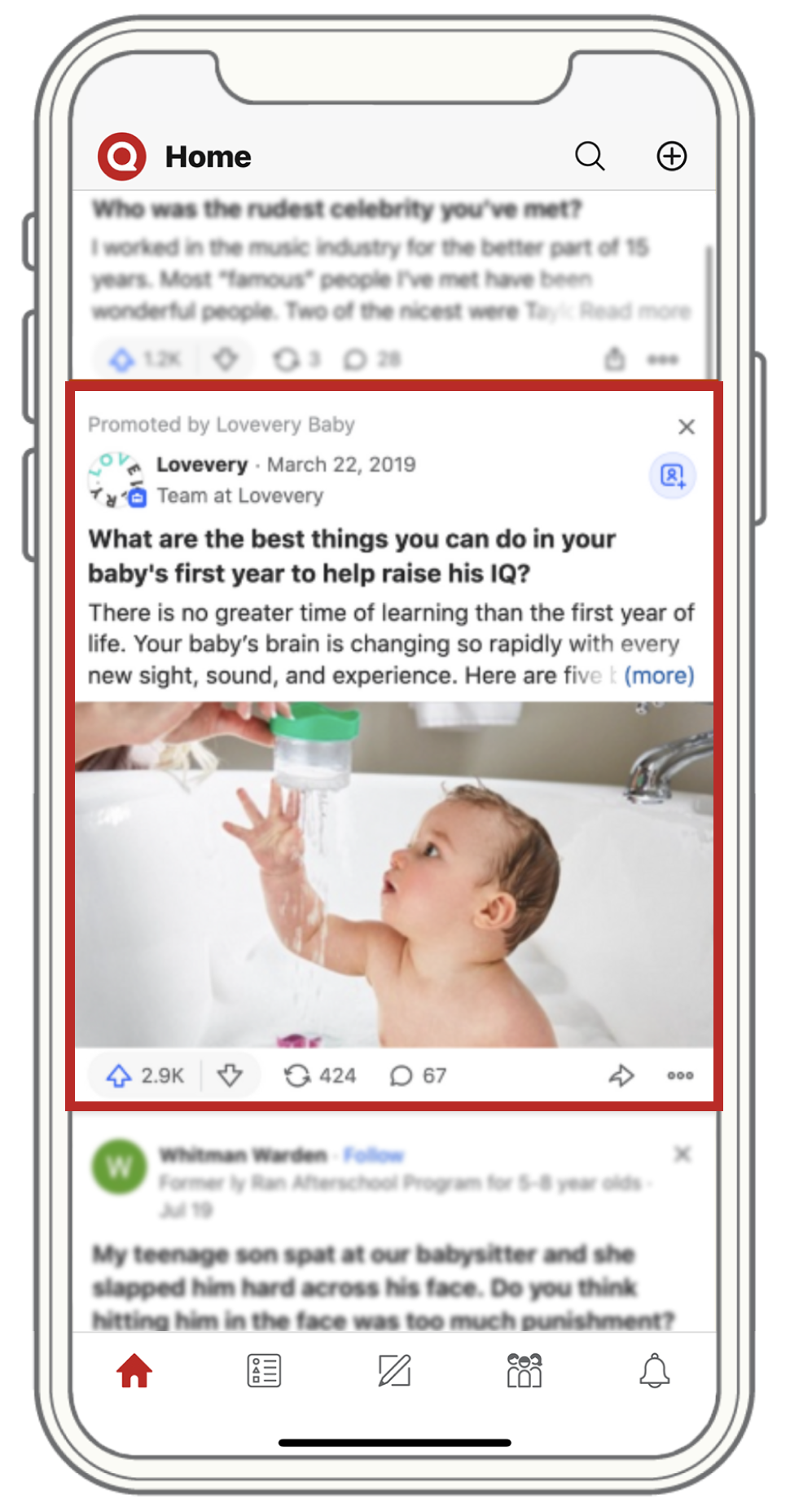
Ad Creative
Promoted Answers allow businesses to exhibit thought leadership in their respective industries. It is ideal for brand awareness or more complex conversations that exceed the 105 character limit in regular ads. As you join and steer conversations related to your brand, promoting answers will increase their visibility.
When creating a Promoted Answer, consider the following best practices:
- Answer questions in a helpful way: Quora users respond best to authentic answers. Avoid misinterpreting the question, rephrasing the question, or mentioning your brand when it isn’t relevant. Answers with the sole purpose of redirecting to a third party site can be marked as spam.
- Provide reusable knowledge: Good answers have facts and insights that are general, reusable, and considerate of different conditions (e.g., “If you’re tall, I recommend X; if you’re short I recommend Y”).
- Hyperlink only when it’s relevant: Less is more, so only use hyperlinks if they provide additional information or if they’re relevant to the question. A random link to a company website can be marked as spam.
- Add images and/or videos: Images and videos included in your answer appear at the top of your Promoted Answer. This helps your ad stand out on Quora.
Optimizing for Awareness
It is important to let ads run for one month before pausing or editing them. Optimizing your campaign pre-maturely can impact your engagement metrics.
- Test image/text ads simultaneously: Image and text ads take users directly to your website. Duplicate campaigns to test these ads alongside Promoted Answers.
- Expand your targeting: Depending on your audience, awareness campaigns can utilize all 10 targeting types on Quora. It is important to test different targeting methods, or sub-themes of topics, to learn where your audience is on Quora.
- Test different Promoted Answers: Some brands see higher engagement with a company profile versus a personal profile, and vice versa. It is also important to answer different types of questions, and not just brand-specific questions.
- Add UTMs to hyperlinks: If your Promoted Answer has a link to your website or blog, add UTMs for additional engagement metrics. This can help determine the most effective URLs in your answers.
- Monitor your Auction Insights: Auction Insights are available at the ad set level, or by configuring your dashboard. These metrics can help you determine the impact of your bid and CTR on auction outcomes, including your impression share.

Tip: To view Auction Insights at the campaign level, click into a campaign and click the “Configure Columns” button. You can add Auction Insights to your campaign dashboard versus clicking into the individual ad sets.
Key Takeaways for Awareness Campaigns
Do:
- Test aggressively: The 10 targeting types and three ad units on Quora can all be used to drive awareness. As you learn where your audience is on Quora, continue reiterating on your targeting and messaging.
- Test Promoted Answers in separate campaigns: These ads behave differently than text and image ads. Having them in a separate campaign will give you control over the amount they spend.
- Organize ad sets based on what’s important to you: If you value device reporting, have separate mobile and desktop ad sets. This also applies to location, gender, and targeting reporting.
Don’t
- Rush to create Promoted Answers: Quality outweighs quantityon Quora. Answers do not have to be long, so allocate time to craft one to two well thought out answers to start. They can always be edited later on.
- Underbid: Competitive bids are still important for awareness campaigns. Your bid is not your final cost, so avoid underbidding. Lower bids can impact your ads’ placement, which can influence traffic quality and user engagement.
Strategy for Conversion Campaigns on Quora
There are many strategies you can adopt to drive conversions on your website. The following recommendations are based on Quora’s best practices, but they can be adjusted to your business accordingly.
Conversion Campaign Structure

Before launching your conversion campaign, install the Quora Pixel. This will allow you to track conversions back to a specific campaign, ad set, and ad. It will also enable important features such as Website Traffic Audiences and Conversion Optimized Bidding.
Once your pixel is installed, you can set up your campaigns. Your campaign’s structure is key to optimizing in the future. If you want targeting-specific reporting, separate your ad sets by primary targeting, geographic region, etc.
An example is on the right-hand side. With this structure, the fictional B2B brand QSmart Technology can effectively optimize for conversions.

How does this structure help drive conversions?
- QSmart Technology can directly compare each targeting type’s performance and allocate budget accordingly.
- QSmart Technology can test additional sub-groups of topics (ex. hotels, airlines, etc.) within one campaign.
- Desktop and mobile tend to have different costs. QSmart Technology can bid competitively for each device.
- Contextual targeting will place QSmart Technology’s ads next to relevant content on Quora.
- The remarketing campaign allows QSmart Technology to customize ads for users who are aware of their brand.
- If Topic, Keyword, and Question Targeting ad sets are in the same campaign, Topic Targeting will consume most of the budget since it has more volume. Keeping Question and Keyword Targeting in a separate campaign allows them to run more efficiently.
Ad Creative
Text and image ads take users directly to your website. It’s imperative to test both to determine which effectively drives more conversions. Take the following best practices into consideration when creating your ads.
- Test statement and question headlines: Questions are native to Quora and tend to drive higher CTRs.
- Adjust your message according to where users are in your funnel, and capitalize on audience pain points.
- Use a landing page with clear next steps: If users aren’t sure where to go on your landing page, they can’t convert.
- Incorporate branding: Consistent brand colors, logos, product shots, and key messaging are more memorable for users.
- Test an image and text version of each creative: If the text version drives more conversions, you may need to update your image. If the image version drives more conversions, test different headlines in your text ads.
If you already tested image and text ads, Promoted Answers can be optimized for conversion campaigns with the following tips:
- Hyperlink only when it’s relevant: Less is more, so only use hyperlinks if they provide additional information or if they’re relevant to the question. A random link to a company website can be marked as spam.
- Add UTMs to hyperlinks: If you choose to include a link to your website or blog, having UTMs in your answer will provide additional engagement metrics.
- Provide reusable knowledge: Good answers have facts and insights that are general, reusable, and considerate of cases with different conditions (e.g., “If you’re tall, I recommend X; if you’re short I recommend Y”)
- Quality over quantity: If you’re just starting with Promoted Answers, focus on writing 1-2 helpful answers. Answers do not have to be long, so focus on answering the user’s question. You can always edit answers in the future.
Pro Tip: Question pages only support Text Ads. Image Ads will convert to text-only if they win these placements, so make sure your message makes sense without an image.
Optimizing for Conversions
It is important to let ads run for one month before pausing or editing them. Optimizing your campaign pre-maturely can impact the volume, quality, and consistency of your conversions.
Campaign Level
Pause under-performers: Pause ad sets and ads that are not generating conversions. This will reallocate budget to the remaining, successful ads. You can also move budget to higher performing campaigns.
Ad Set Level
- Test new targeting strategies: Try new subgroups of topics based on your industry, competitors, or target market personas. You can also use the “Import Ad Set” tool to switch Contextual Targeting ad sets into Behavioral Targeting, and vice versa.
- Utilize Audience Targeting: Build Lookalikes from a successful Website Traffic Audience or an email list of existing customers (List Match). You can also exclude audiences to reach net-new customers.
- Bid competitively: Bids are not your final CPC, but they will determine the number and quality of auctions you win. Low bids tend to win lower ad placements, which have less engagement, lower quality clicks, and fewer conversions.
- Conversion Optimized Bidding: This bidding method uses conversion data to deliver ads to users who are more likely to convert. An ad set must have 20+ conversions per week for this bidding to operate effectively. Using Conversion Optimized Bidding without conversion history will result in little to no ad delivery.
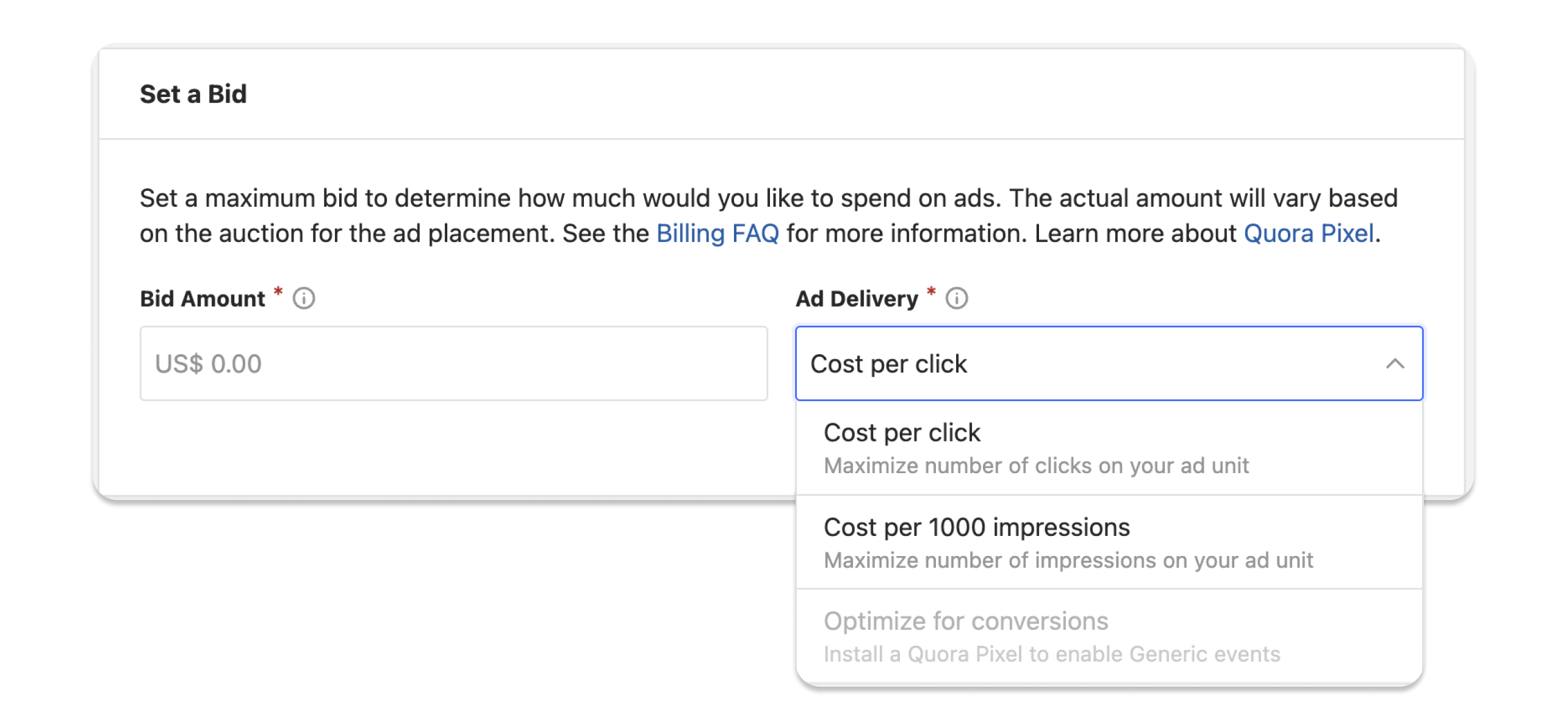
Ad Level
- Prioritize conversions: The ad with the highest CTR may not always have the best ROI. If an ad is generating clicks but no conversions, consider pausing it and updating the landing page.
- Review your landing pages: Does your call to action match the landing page? Is it clear what action a user is supposed to take on your website? If not, consider testing additional landing pages.
- Test new creatives: Continue testing creatives to find a winning combination of headlines, body texts, images, etc. If you already have image and text ads, consider testing Promoted Answers.
The following steps can be used to test and optimize your ad creatives. For text ads, apply these steps to your body text and headlines.
A. Test different images with the same message.
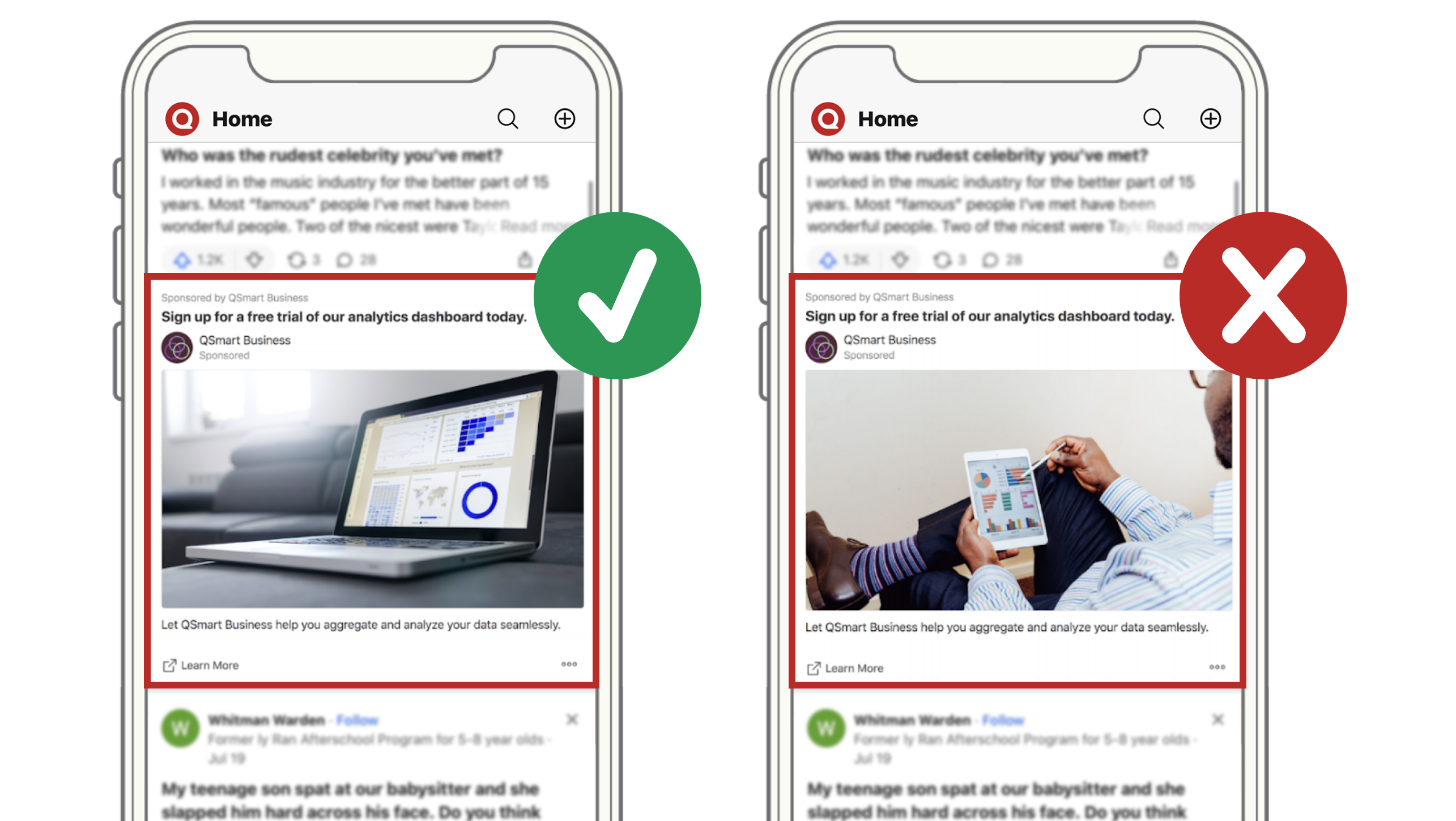
B. Test the winning image with a new message.
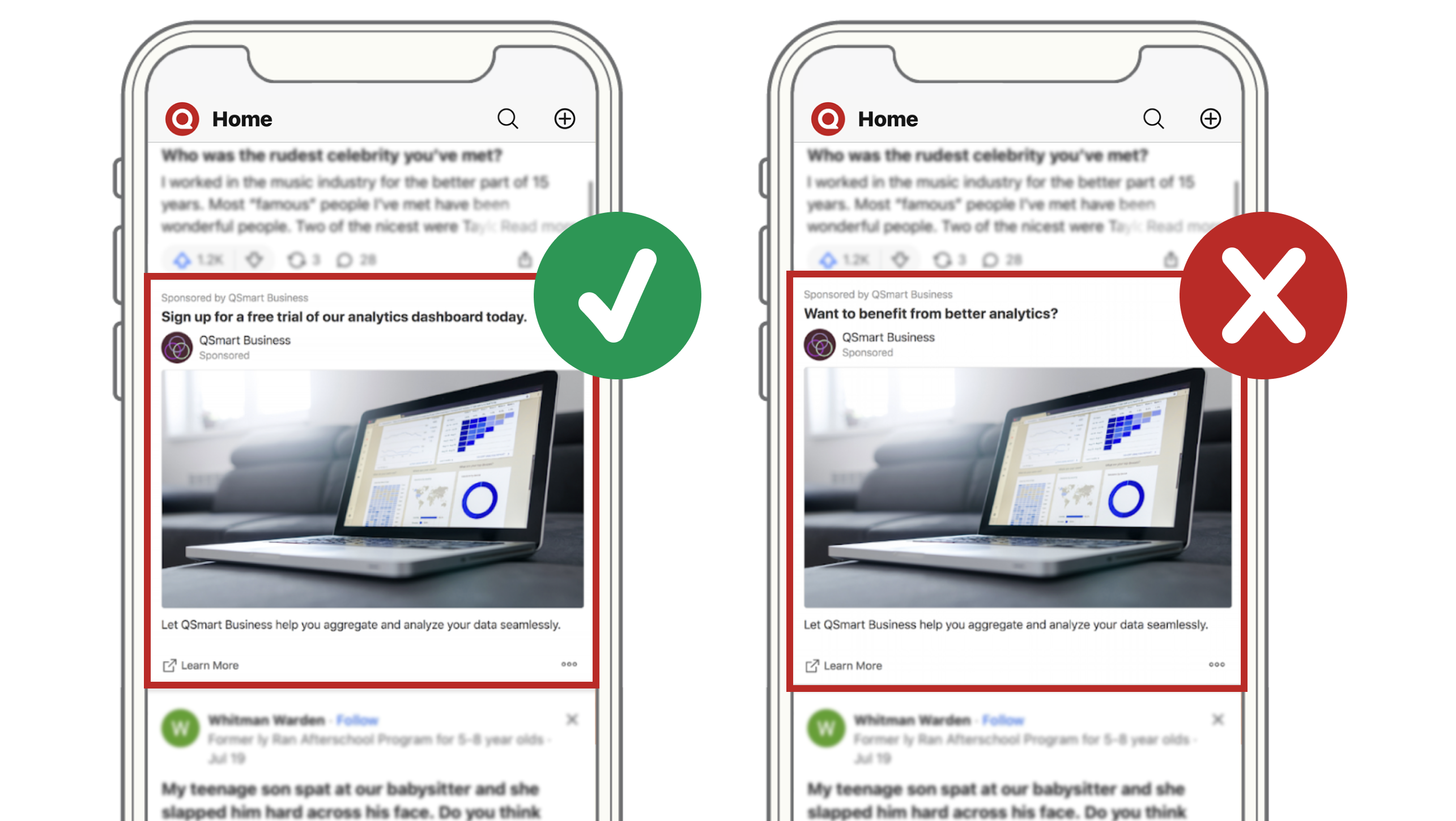
C. Test the winning message with a new image. Repeat.
Key Takeaways for Conversion Campaigns
Do
- Install the Quora Pixel: Insights from the pixel will be key to optimizing your campaign and improving CPAs.
- Organize ad sets based on what’s important to you: If you value device reporting, have separate mobile and desktop ad sets. This also applies to location, gender, and targeting reporting.
- Test aggressively: All 10 targeting types on Quora can be used for conversion campaigns. There are also three ad formats available. As you learn where your audience is on Quora, continue reiterating on your targeting and messaging.
Don’t
- Start with Conversion Optimized Bidding: This bidding method relies on conversion data to operate efficiently. If your ad set has insufficient conversion history, your ads will have little to no delivery.
- Test pre-maturely: Set aside enough time and budget to test Quora Ads for at least one month. Limiting yourself to one targeting type, or pausing campaigns too soon, can impact the number and quality of conversions you generate on Quora.
Related Content

For Advertisers

Integrations
Book a consultation with a Quora expert
![]()
